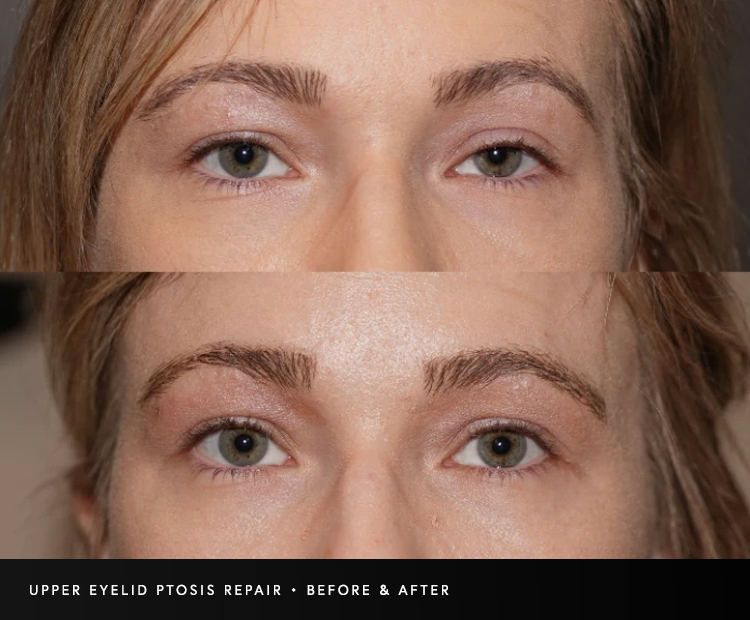Ptosis Repair
What is ptosis?
Ptosis, also known as blepharoptosis, is a condition characterized by drooping of the upper eyelid. In the case of ptosis, drooping is caused by damage or stretching of the muscles that raise the eyelid. Ptosis is usually bothersome to patients when it worsens the appearance of facial asymmetry or causes one to look more tired than they are.
Ptosis is typically diagnosed by appearance. However, the underlying cause must be determined though a comprehensive eye exam. Dr. Moore will review your medical history to identify any underlying conditions or factors that may be contributing to your condition and assess the impact of the drooping eyelid. He may perform various tests to evaluate the muscles of your eyelid. He will also take measurements of the eyelids to determine the severity of the droop. With this information, he will recommend treatment options.
Ptosis repair is a surgical procedure performed to correct drooping of the upper eyelid by tightening the muscles that elevate the eyelid. The goal of ptosis surgery is to elevate the eyelid to a natural level and enhance the aesthetic appearance of the eye. When considering ptosis surgery, it is important to be evaluated by an oculoplastic surgeon, like Dr. Grant Moore.
There are various surgical techniques available. The choice of procedure depends on various factors including the underlying cause and severity of the condition.
Some common approaches include:
- Levator Advancement: This method involves tightening the levator muscle, the primary muscle responsible for lifting the eyelid. During surgery, Dr. Moore makes an incision in the eyelid crease and tightens the levator muscle by suturing it to a more favorable anatomic position. This creates improved eyelid elevation.
- Müller’s muscle resection: This technique is primarily used for mild to moderate cases of ptosis. Müller’s muscle is a smooth muscle that assists in elevating the eyelid. In this procedure, Dr. Moore operates on the back surface of the upper eyelid. He flips the eyelid to access Müller’s muscle and then shortens the muscle to raise the eyelid. Müller’s muscle resection surgery is unique in that it does not require a skin incision.
- Frontalis sling procedure: This method is employed when the levator muscle is significantly weakened or damaged. It involves attaching the eyelid to the forehead muscles (frontalis muscle) just above the brow, using a small, silicone tube. By connecting the eyelid to the frontalis muscle, this surgery allows patients to elevate their eyelid by lifting their forehead.
Ptosis repair is typically performed under local anesthesia with IV sedation. Recovery time varies depending on the extent of the surgery. Patients are usually advised to avoid strenuous activities and keep the eyelids clean during the healing process.
Schedule a consultation
If you would like to learn more about ptosis surgery, please schedule a consult with Dr. Moore. At your consult, he will discuss the different options for ptosis repair and recommend the surgical technique that he feels is most likely to meet your needs. He will also discuss the risks and benefits of the recommended surgery.
Scottsdale, Arizona surgeon, Dr. Grant Moore, is an oculofacial plastic surgeon who specializes in cosmetic and reconstructive surgery of the eyelids, eyebrows, face, and forehead. Oculofacial plastic surgeons have specialty training in ophthalmology and facial plastic and reconstructive surgery.
References
- https://www.aoa.org/healthy-eyes/eye-and-vision-conditions/ptosis?sso=y
- https://www.healthline.com/health/eyelid-drooping
At a Glance
Grant Moore, MD
- Board Certified, Oculofacial Plastic Surgeon
- Over 5000 blepharoplasty surgeries performed
- Assistant Professor, University of Arizona-Phoenix
- Learn more


